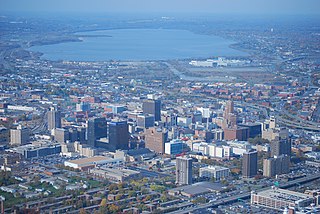
Downtown Syracuse is the economic center of Syracuse, New York, and Central New York, employing over 30,000 people, and housing over 4,000.
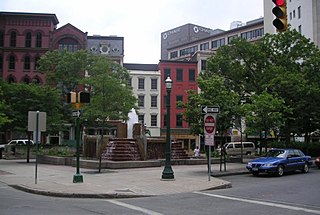
Hanover Square in downtown Syracuse is actually a triangle at the intersection of Warren, Water, and East Genesee Streets. The name may also refer to the larger Hanover Square Historic District which includes seventeen historic buildings in the area that was the first commercial district in Syracuse. In the warm weather months, entertainment is common on the plaza around the fountain. Workers in the surrounding office buildings and retail establishments often lunch there.
The National Register of Historic Places listings in Syracuse, New York are described below. There are 109 listed properties and districts in the city of Syracuse, including 19 business or public buildings, 13 historic districts, 6 churches, four school or university buildings, three parks, six apartment buildings, and 43 houses. Twenty-nine of the listed houses were designed by architect Ward Wellington Ward; 25 of these were listed as a group in 1996.
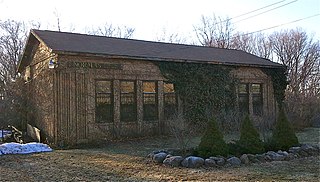
The Southwood Two-Teacher Schoolhouse is a historic school building located on Barker Hill Road just south of East Seneca Turnpike, in the Southwood neighborhood of the town of Onondaga, Onondaga County, New York. Further east along the turnpike is the hamlet of Jamesville, New York. It was built in 1937–1938, and is a one-story, yellow brick Art Deco style building, but the ivy hides any architectural details that would show that. The rectangular building has a full concrete block basement and is topped by a flat roof. It remained in use as a school until 1966.

There are 69 properties listed on the National Register of Historic Places in Albany, New York, United States. Six are additionally designated as National Historic Landmarks (NHLs), the most of any city in the state after New York City. Another 14 are historic districts, for which 20 of the listings are also contributing properties. Two properties, both buildings, that had been listed in the past but have since been demolished have been delisted; one building that is also no longer extant remains listed.

Martisco station, also known as Martisco Station Railway Museum, is a railroad station in Martisco, Onondaga County, New York. It was built in 1870 by the Auburn and Syracuse Railroad, and is a two-story, Italianate style brick building. Decorative brackets support an unusually long overhang of the roof. The line and station were eventually acquired by the New York Central Railroad. The station is owned by the Central New York Chapter of the National Railway Historical Society, and is open as a museum during limited hours in the summer. Adjacent to the station is a contributing Pennsylvania Railroad dining car.

South Salina Street Downtown Historic District is a historic district representing what was the commercial core of in Syracuse, New York from the mid-nineteenth century to the mid-twentieth century. It was listed on the National Register of Historic Places on October 16, 2009. The vacancy rate in the district is high, and some buildings need extensive rehabilitation. Recent revitalization plans served as impetus for seeking listing on the National Register of Historic Places.

The William H. Moore House, also known as the Stokes-Moore Mansion and once home to the America-Israel Cultural Foundation, is a historic building located in New York, New York. The building was designed by the architecture firm McKim, Mead & White and built between 1898 and 1900. It is a five-story, rectangular stone building in the Renaissance Revival style. It has an English basement and flat roof with balustrade and overhanging cornice. It was commissioned by William Earle Dodge Stokes (1852–1926), and purchased by financier William Henry Moore (1848-1923) before its completion. His wife resided in the house until her death in 1955, after which it housed a succession of commercial and charitable organizations, including the Banco di Napoli.

The New Kasson Apartments is a historic apartment building located on James Street in the Near Northeast neighborhood of Syracuse, Onondaga County, New York. It was designed by architectural firm of Merrick and Randall and built in 1898. It is a seven-story, Renaissance Revival style building consisting of two rectangular multi-story blocks. It is a yellow brick and limestone building with cast stone and terra cotta details. The facades features projecting three-sided bays extending from the first through fifth floors. It is located across from the Leavenworth Apartments built in 1912.

Scottholm is an historic housing development in the Meadowbrook neighborhood of Syracuse, Onondaga County, New York. It has been registered as a National Historic District. It is bounded by Salt Springs Road on the north; Brookford Road and East Avenue on the east; Meadowbrook Drive on the south; and Scottholm Terrace on the west. Scottholm consists of single‐family homes of varying styles built in the early 20th century. When it was built, Scottholm was marketed to upper middle class and upper class residents. Today, the area attracts a diverse population of white collar, academic, and creative class professionals. Nottingham High School, in the Syracuse City School District, is nearby.

Central Avenue Historic District is a national historic district located at Lancaster in Erie County, New York. The district encompasses 17 contributing buildings in the central business district of the village of Lancaster. The district includes a variety of residential, commercial, and government buildings built between about 1860 and 1940. It includes notable examples of Italianate and Colonial Revival style architecture. Notable buildings include the Lancaster Town Hall and Opera House, Former Post Office, Cushing Block, and Potter-Eaton House.
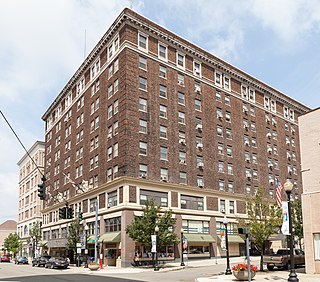
Jamestown Downtown Historic District is a national historic district located at Jamestown in Chautauqua County, New York. The district encompasses 103 contributing buildings in the central business district of Jamestown. The district developed between about 1873 and 1956, and includes buildings in a variety of architectural styles including Italianate, Gothic Revival, Second Empire, Romanesque Revival, Classical Revival, Renaissance Revival, and Art Deco. Located in the district is the separately listed Wellman Building. Other notable buildings include the Arcade Building (1898), Odd Fellows Lodge (1914), Bank of Jamestown, Hotel Samuels (1910), Hotel Jamestown (1924), Chautauqua School of Nursing (1911), Jamestown Telephone Company (1930), Maddox Building (1933), First National Bank (1953), Pennsylvania Gas Company building, Chautauqua National Bank (1956), Palace Theatre, Allen's Opera House, and the former Broadhead Worsted Mills.
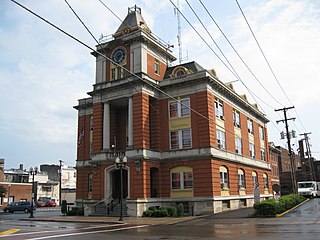
Geneva Downtown Commercial Historic District is a national historic district located at Geneva, Ontario County, New York. It encompasses 83 contributing buildings in the central business district of Geneva. They were built between about 1840 and 1940, and include notable examples of Greek Revival, Italianate, Romanesque Revival, Colonial Revival, and Art Deco style commercial architecture. Located in the district are the separately listed Farmers and Merchants Bank, Smith's Opera House, and United States Post Office. Other notable buildings include the Prouty Block (1876), YMCA (1902), Wheat Building (1904), Guard Building, Geneva City Hall, Odd Fellows Building (1884-1890), and Kresge Building (1928).

The Downtown Commercial Historic District encompasses most of the central business district of Burlington, Iowa, United States. It was listed on the National Register of Historic Places in 2015. The historic district includes 65 properties that were part of a 2012 to 2013 survey of the area. It also includes as contributing properties the buildings in the West Jefferson Street Historic District and three buildings in the Manufacturing and Wholesale Historic District that were previously listed on the National Register. All total there are 122 resources within the district, which includes 108 contributing and 14 non-contributing properties.

Farmer's National Bank and W.H. Hughes Slate Company Office, also known as the Granville Town Hall, is a historic commercial building located at Granville, Washington County, New York. The original section was built in 1891, and expanded twice between about 1912 and 1943. It is a two-story, five bay, cut limestone and brick building with a Romanesque style arched entrance. It has housed Granville town offices since about 1945.

Leavenworth Apartments is a historic apartment building located in the Near Northeast neighborhood of Syracuse, Onondaga County, New York. It was designed by architect Charles Erastus Colton and built in 1912. It is a seven-story, Colonial Revival style asymmetrical building in six sections. It is a steel frame and masonry building with cast stone details. The building features stepped gable ends. It is located across from the New Kasson Apartments built in 1898.

Odd Fellows Lodge and Temple, also known as the Lincoln Lodge, is a historic Odd Fellows Lodge located near Downtown Syracuse, Onondaga County, New York. It was built in 1887, and is a three-story, Romanesque Revival style brick building. It features decorative brickwork and was expanded before 1892. It housed a public library on the first floor, lodge related dwellings on the second floor, and the Odd Fellows meeting hall on the third. It was originally a German-speaking Lodge and vacated the building in 1945.

116 John Street is a historic office tower at the southwest corner of John Street and Pearl Street in the Financial District of Lower Manhattan in New York City. It was built in 1931, and is a 35-story brick and terra cotta building consisting of a three-story base, a 19-story shaft, and 12 upper stories that recede in a series of setbacks. The building features Art Deco style design elements at the recessed entrances and in the lobby. Built as a speculative office building for insurance companies, the building interior was rehabilitated in 2013 and some floors converted to apartments.

Broadway Historic District is a national historic district located at Lancaster in Erie County, New York. The district encompasses 85 contributing resources in the village of Lancaster. The district includes a variety of commercial, residential, religious and institutional buildings built between about 1831 and 1940. It includes notable examples of Greek Revival, Italianate, Queen Anne, Colonial Revival, and Bungalow / American Craftsman style architecture. Located in the district are the separately listed Lancaster Municipal Building (1940), Miller-Mackey House, Clark-Lester House, Bruce-Briggs Brick Block, Lancaster Masonic Lodge Hall (1916-1919), Liebler-Rohl Gasoline Station, Dr. John J. Nowak House, Zuidema-Idsardi House, Herman B. VanPeyma House, and John Richardson House. Other notable buildings include the Seeger Store Building, Brost Building designed by Edward Brodhead Green, Maute House, Depew Lancaster Moose Lodge No. 1605 B.P.O.E. Lodge/Potter's Hall, and Lancaster Presbyterian Church (1832-1833).






















